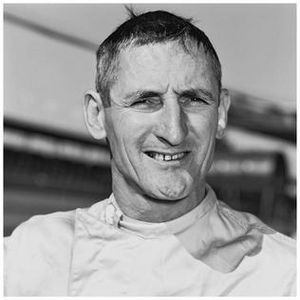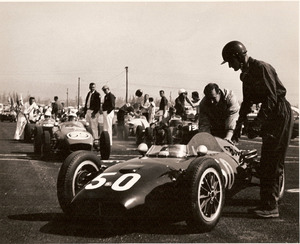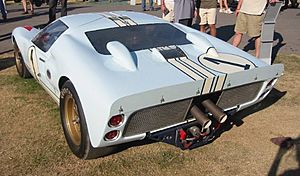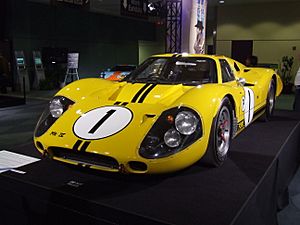Ken Miles facts for kids
Quick facts for kids
Ken Miles
|
|
|---|---|

Ken Miles
|
|
| Personal details | |
| Born |
Kenneth Henry Jarvis Miles
1 November 1918 Sutton Coldfield, Warwickshire, England |
| Died | 17 August 1966 (aged 47) Riverside International Raceway, California, U.S. |
| Resting place | Hollywood Forever, Hollywood, California, U.S. |
| Citizenship | United Kingdom, United States |
| Military service | |
| Allegiance | United Kingdom |
| Branch/service | |
| Years of service | 1939–1945 |
| Rank | Staff Sergeant |
Kenneth Henry Jarvis Miles (born November 1, 1918 – died August 17, 1966) was a British-American race car engineer and driver. He was famous for his amazing skills in sports car racing, especially in the United States. Ken Miles is honored in the Motorsports Hall of Fame of America for his contributions to racing.
Contents
Early Life and Military Service
Ken Miles was born in Sutton Coldfield, England. When he was 15, he left school to become an apprentice at Wolseley Motors. This helped him learn a lot about building vehicles. Before World War II, he raced motorcycles.
During World War II, Ken joined the British Army. He became a driving instructor and later worked with vehicle mechanics. He served in Europe as a tank commander. This experience made him love high-performance engineering even more. He left the army in 1946.
Racing Career Highlights
After the war, Ken Miles started racing different cars like Bugattis and Alfa Romeos. In 1952, he moved from England to Los Angeles, California. He quickly became known for his racing talent.
In 1953, he won 14 races in a row in a special car he designed himself. It was based on an MG car. He also built another successful car called the "Flying Shingle" in 1955.
Working with Carroll Shelby
Ken Miles was a very important part of the Shelby/Cobra race team in the early 1960s. He was a skilled driver and a brilliant engineer. His teammates often called him "Teddy Teabag" because he loved tea, or "Sidebite" because of his accent.
He helped develop famous race cars like the Shelby Cobra 289, the Daytona Coupe, and the powerful Ford GT (GT40). In 1963, he became the chief test driver for Shelby-American. He was known for being very polite on the track.
Major Races and the Le Mans Controversy
In 1965, Ken Miles raced a Ford GT Mk II at the 24 Hours of Le Mans with Bruce McLaren. They had to stop early due to a problem. Earlier that year, they finished second at the 12 Hours of Sebring.
The next year, 1966, was a huge year for Ken. He won the 24 Hours of Daytona and then the 12 Hours of Sebring with his co-driver Lloyd Ruby. He was on track to win the 1966 24 Hours of Le Mans too, which would have been an amazing achievement.
However, during the Le Mans race, a Ford executive wanted all three Ford cars to cross the finish line together for a famous photo. Ken Miles, who was leading, was told to slow down. He did, and the other two Ford cars caught up. Even though Ken's car crossed the line at the same time as Bruce McLaren's car, the officials declared McLaren the winner. This was because McLaren's car had started slightly behind Ken's, so it had covered a tiny bit more distance. This decision stopped Ken from winning all three major endurance races in one year.
Death
In August 1966, Ken Miles was testing a new Ford race car called the J-car. This car was meant to be even better than the GT40 Mk II. While testing at Riverside International Raceway in California, the car crashed at very high speed. Ken Miles died instantly in the accident.
After the crash, engineers made big changes to the J-car's design to make it safer. The improved car was renamed the Ford Mk IV. It went on to win the 1967 12 Hours of Sebring and the 1967 24 Hours of Le Mans the following year.
Ken Miles is buried at the Hollywood Forever Cemetery in Hollywood, California.
Awards and Honours
In 2001, Ken Miles was honored by being added to the Motorsports Hall of Fame of America. This recognized his important role and achievements in racing.
Personal Life
Ken Miles was married to Mollie and they had a son named Peter. Ken was also a close friend of the famous car designer Carroll Shelby. Peter was almost 16 when his father passed away. Later, Peter worked in the custom car industry and became a successful crew chief in racing.
See also
 In Spanish: Ken Miles para niños
In Spanish: Ken Miles para niños




